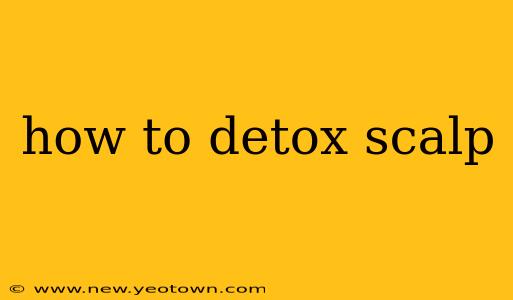Let's be honest, we shower regularly, cleanse our faces meticulously, but often neglect the scalp – the foundation for healthy, vibrant hair. A buildup of product residue, sweat, oil, and environmental pollutants can clog pores, leading to irritation, dandruff, and even hair loss. Think of it like this: a clogged scalp is like a choked garden – it can’t thrive! This comprehensive guide will walk you through effective ways to detox your scalp and bring back its natural shine and health.
What is Scalp Detoxing, and Why is it Important?
Scalp detoxing is the process of removing impurities and buildup from your scalp, promoting a healthier environment for hair growth. It's not about harsh scrubbing; it's about gentle yet effective cleansing to unclog follicles and stimulate blood circulation. A clean scalp leads to stronger, shinier hair that's less prone to breakage, dandruff, and other scalp issues.
How Often Should I Detox My Scalp?
The frequency depends on your hair type and lifestyle. Those with oily hair or who use a lot of styling products might benefit from a scalp detox every 1-2 weeks. If you have dry hair or use minimal products, once a month might suffice. Over-detoxing can strip your scalp of its natural oils, leading to dryness and irritation.
What are the signs of a needing a scalp detox?
This is a common question, and the answer is multi-faceted. Signs you need a scalp detox include:
- Itchy scalp: Persistent itching indicates irritation, often from product buildup or an imbalanced scalp microbiome.
- Dandruff: White flakes are a clear sign of scalp imbalance, often worsened by buildup.
- Oily scalp: Excessive oiliness can lead to clogged pores and hinder hair growth.
- Dry scalp: While seemingly the opposite of oily, dryness can also be caused by buildup preventing the scalp from absorbing moisture effectively.
- Slow hair growth: Clogged follicles can inhibit hair growth.
- Hair loss: In some cases, significant buildup can contribute to hair follicle inflammation and subsequent hair loss.
- ** Dull, lifeless hair:** A healthy scalp contributes to shiny, vibrant hair. Dullness can be a sign of underlying scalp issues.
How to Detox Your Scalp at Home: Simple and Effective Methods
There are several ways to detox your scalp at home, ranging from simple adjustments to your hair care routine to more intensive treatments.
1. Using a Clarifying Shampoo:
A clarifying shampoo is your first line of defense. These shampoos are formulated to remove product buildup, oil, and other impurities without being overly harsh. Look for shampoos with ingredients like chelating agents (to bind to minerals and remove them), clarifying clays, or gentle surfactants. Use it once or twice a month, depending on your hair and scalp needs. Remember, even clarifying shampoos should be used sparingly to avoid stripping your scalp of its natural oils.
2. DIY Scalp Scrubs:
You can create your own scalp scrub at home using natural ingredients. A simple option includes mixing baking soda with a small amount of water or your favorite conditioner to create a paste. Gently massage this onto your scalp and rinse thoroughly. Other options include sugar scrubs with coconut oil or honey. Caution: Be gentle when scrubbing to avoid scratching your scalp.
3. Apple Cider Vinegar Rinse:
Apple cider vinegar (ACV) is known for its balancing properties. Dilute it with water (a ratio of 1:1 or 1:2 ACV to water is a good starting point), and apply it to your scalp after shampooing. Let it sit for a few minutes before rinsing thoroughly. The acidity helps to balance the scalp's pH and remove buildup.
4. Essential Oils:
Certain essential oils, like tea tree oil, peppermint oil, and rosemary oil, possess antimicrobial and stimulating properties that can benefit the scalp. Dilute them with a carrier oil like coconut oil or jojoba oil before applying them to your scalp. Always conduct a patch test before applying essential oils to your whole scalp to check for any allergies or sensitivities.
5. Regular Brushing:
Regular brushing helps to remove dead skin cells and distribute natural oils throughout your hair. Use a soft-bristled brush and gently brush your scalp in circular motions.
Maintaining a Healthy Scalp After Detoxing
Detoxing your scalp is just the first step. Maintaining a healthy scalp requires ongoing care:
- Choose the right shampoo and conditioner: Select products formulated for your hair type and scalp concerns.
- Avoid harsh chemicals: Limit the use of products with sulfates, silicones, and parabens.
- Hydrate: Drink plenty of water to keep your scalp and hair hydrated.
- Eat a healthy diet: Nutrition plays a significant role in hair and scalp health.
- Manage stress: Stress can negatively impact scalp health.
By following these tips, you can enjoy a healthy, happy scalp and beautiful, vibrant hair. Remember to listen to your scalp's needs and adjust your routine accordingly. If you have persistent scalp issues, consult a dermatologist or trichologist for professional advice.

